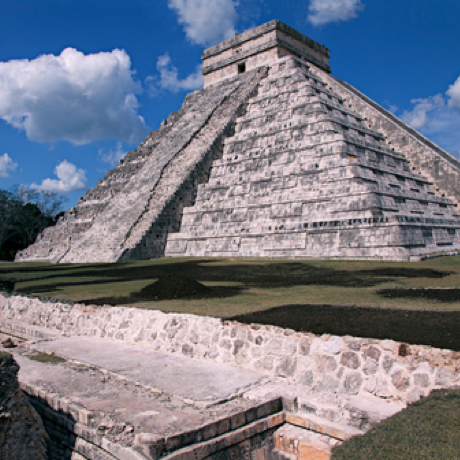Location of Chichen Itza in Mesoamerica, Mexico
I'm in Mexico for Alissa Malzman and Justin Sterling's destination wedding. I've scoured the map already andknow that the location of their ceremony is within driving distance of Chichen Itza, the great Mayan architectural site on the Yucatan Peninsula. I've got my camera and have hired a driver and a guide. There is only one problem. I'm sick! I have a temperature of 101 degrees, chills, and early laryngitis. Oh well...I'm not getting this close to a pre-Columbian colossus and staying in my motel room staring at the ceiling. I take 2 Tylenols and hop in the car for what I know will be a mind-expanding experience.
Temple of Kukulkan, referred to as El Castillo
We've arrived quite early, before the tourist buses have started to appear. I've arranged this by design, and it has paid off. What I see before me was at one time a major focal point in the Northern Mayan Lowlands from the Late Classical period through the beginning part of the Post-Classical period (approximately A.D. 600 - A.D. 1200). This was a great mythical city as regarded in Mesoamerican literature, with many different architectural styles. I love these kinds of World Heritage Sites!
Great Ball Court
Chichen Itza is a Spanish name that means, "at the mouth of the Itza." Chi means "mouth" and Chen means "well." In 2007 it was put on the list of the new 7 wonders of the world. As I look around I can see how this metropolis was the principal ceremonial center of the Yucatan. Covering 5 square kilometers, the main architectural layout is structured around the site's core.
Tzompaniti (Skull Platform)
Our first stop is to see the Kukulkan Pyramid, also known as El Castillo (The Castle). This structure dominates the center of the archaeological site. It is a stepped pyramid that stands approximately 30 meters high. There are 9 square terraces stacked upon each other with a high temple found at its summit. In the 1930s, the Mexican government began excavating El Castillo. This revealed a staircase under the north side of the pyramid that revealed another temple buried below the current one, as shown below.
Eagle and Jaguar Platform
I am fascinated by the Great Ball Court. Located 150 meters north-west of El Castillo, this venue was used for playing a Mesoamerican ballgame and is the largest ball court of its kind to be discovered. It is much more expansive than an American football field, and I can see ornate carvings and inscriptions on various walls. Embedded high on each wall is a stone hoop that has been engraved with intertwining feathered serpents.
I really like the Tzompaniti, or the Skull Platform. The skulls are stacked up vertically, as opposed to those found in Tenochtitlan, an Aztec site where a horizontal presentation is found.
El Caracol, Observatory Temple
A short distance away is the Platform of the Eagles and the Jaguars. I first notice the staircases on each of its four sides, showing both Mayan and Toltec influences. When you study the panels you can see that the eagles and jaguars are consuming human hearts. Suddenly I'm not that hungry for lunch!
I continue to cruise over to El Caracol, otherwise known as The Observatory, learning that there were some world class astronomers amongst the Mayans. This is a round building atop a large square platform that was used to track the path of Venus, amongst other things.
Well, the sun is getting higher in the sky, and the busloads of tourists are beginning to arrive. I'm starting to experience arthralgias (joint pains), and I'm thinking that I might feel worse than the humans who had their hearts consumed by the Eagles and Jaguars. My photo op has come to an abrupt end. Despite the adversity, I've seen one of the world's true gems!







